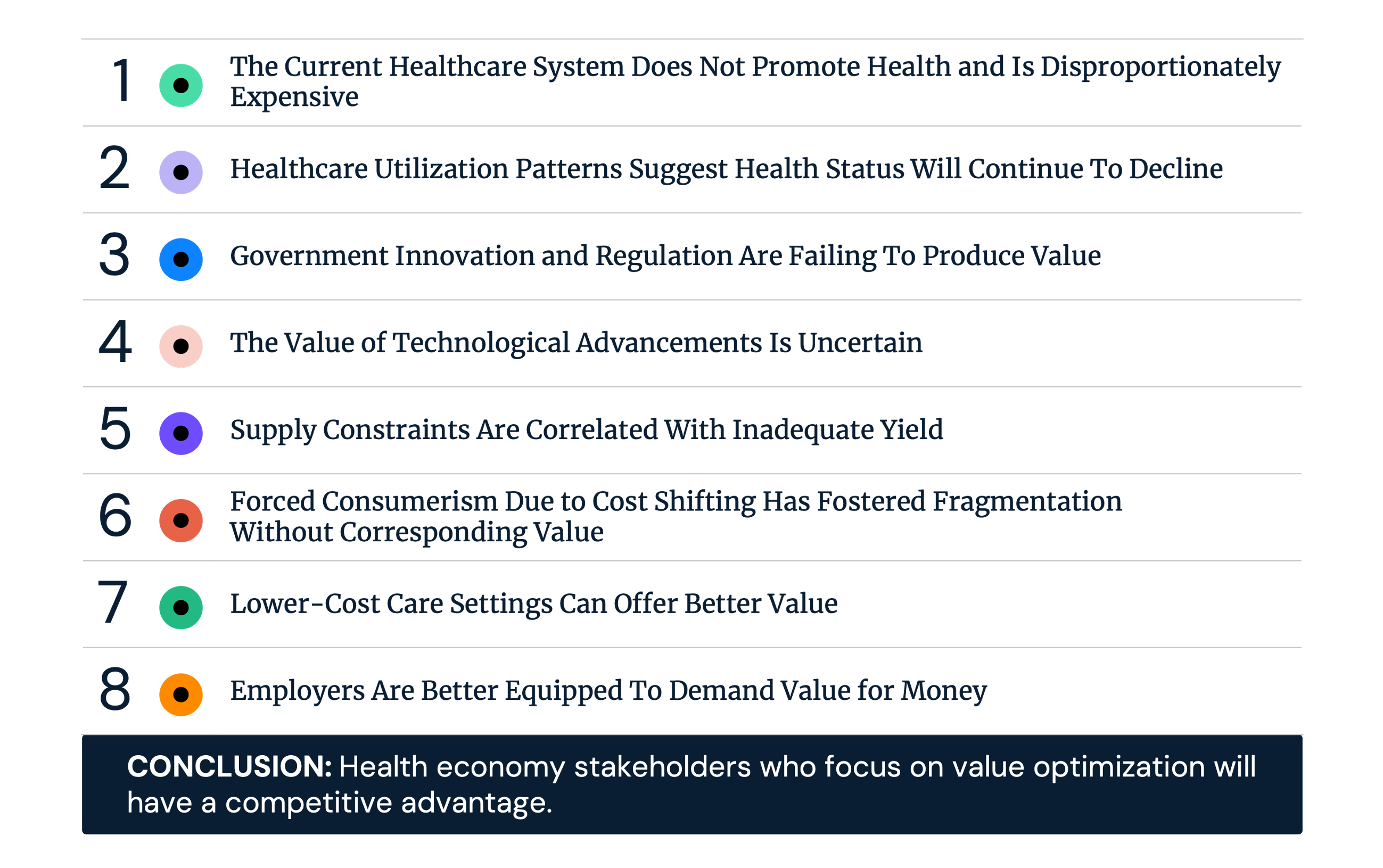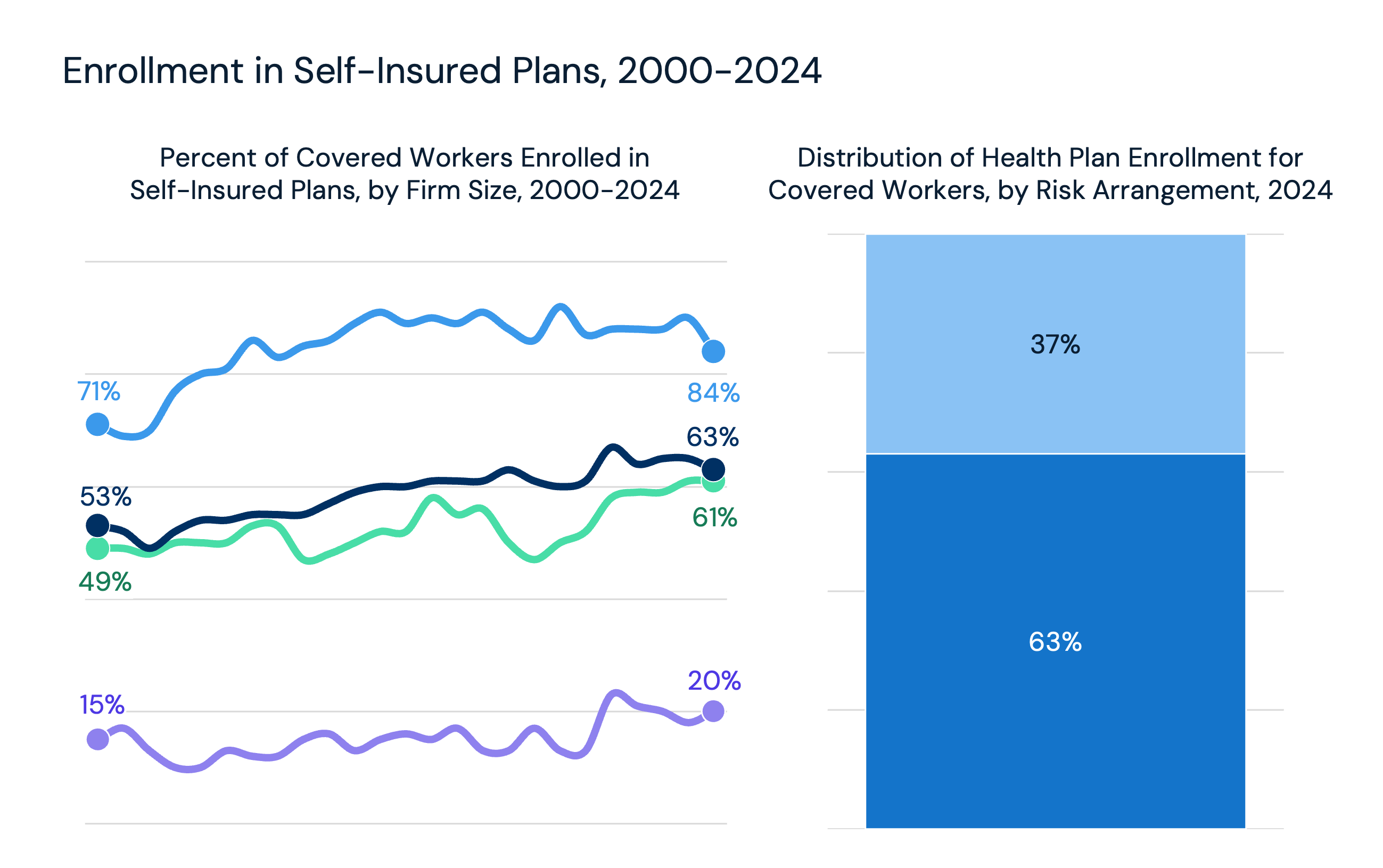Studies Archive
Four Years of Trends: Reviewing the Fundamentals Underlying the Trends Shaping the Health Economy
September 29, 2024In 2021, I created The Compass with the goal of analyzing healthcare trends through the lens of economic principles – supply, demand and yield. This approach stemmed from a longstanding observation: for years, the U.S. healthcare system has functioned as if the fundamental rules of economics do not apply. Alongside the launch of The Compass, we also initiated work on our most comprehensive research publication, the Trends Shaping the Health Economy series. Since 2021, we have published three such reports, where hundreds of data stories offer insight into the evolving health economy. The key takeaways of the previous reports are:
- 2021: Healthcare is a negative-sum game.
- 2022: Every part of the health economy will be impacted by reduced yield.
- 2023: The winners in healthcare’s negative-sum game will be those who deliver value for money.
In the coming days, we will release the fourth installment of the Trends Shaping the Health Economy series. Our conclusions from 2021, 2022 and 2023 are foundational to analyze and interpret the eight secular trends identified for 2024.
Healthcare is a negative-sum game (2021)
While game theory is infrequently, if ever, discussed in healthcare, nothing will have a more profound effect on the direction of the health economy over the next 20 years. Healthcare is what game theorists call a “negative-sum game,” or a situation in which the total gains and losses are less than zero (Figure 1). This is largely due to the following key macroeconomic trends:
- Demand for healthcare services is flat to declining;
- Settings of care are plentiful and growing; and
- To compete in a low-demand, high-supply economy, price is a critical lever.
Operating in a negative-sum game means that every stakeholder will still lose in comparison to what they currently have or really need. There is no way to win a losing game without competing, but there are a few ways to compete seriously: winning key battles, cutting losses early, losing less frequently and losing by a smaller margin than the competition. However, winning more or losing less than the competition is virtually impossible without accurate and actionable data.
Since 2021, this dynamic has intensified as the commercially insured market shrinks due to factors like 11,000 Americans aging into Medicare each day, America’s declining birth rate, a surge in excess mortality among the under 40 population and population migration trends. Additionally, rising healthcare costs, growing consumerism, heightened antitrust scrutiny, increased examination of hospital and health system finances and mounting pressure for price transparency have further intensified competition in healthcare’s existing negative-sum game.

Every part of the health economy will be impacted by reduced yield (2022)
According to the laws of economics, when supply increases but demand does not change, prices decline. This has not been the case in healthcare. As rising healthcare unaffordability becomes a greater concern for Americans in tandem with declining health status, how much longer can the health economy escape the laws of economics? In the words of the economist Herb Stein, “if something cannot go on forever, it will stop.”
Healthcare spending accounts for almost 20% of U.S. GDP. The prices that commercial health insurers pay are much higher and are rising more quickly than the prices paid by public insurance programs. The Congressional Budget Office has developed a framework for how Federal legislation might address high commercial prices, which result from negotiations between private payers and hospitals or physician groups. While two of the three policy options— promoting price transparency and provider competition — are familiar to health economy stakeholders, the third policy option – to limit commercial prices – is one that would dramatically change the game for every stakeholder.
Every stakeholder must consider and prepare for the implications of reduced yield in a post-pandemic health economy (Figure 2). While every stakeholder would be affected, payers will inevitably come out on top relative to other stakeholders.
Since 2022, this trend has accelerated. Price transparency has revealed wide variations in prices and discrepancies between cost and quality, flat to declining demand for healthcare services persists despite a rising disease burden and the Federal government has increased efforts to regulate commercial healthcare prices. The question is how long, not whether, the health economy can continue to defy the laws of economics.

The winners in healthcare’s negative-sum game will be those who deliver value for money (2023)
In a negative-sum health economy defined by reduced yield, the only way to “lose less” is to compete on value. The commercial health plan data that was made public under CMS’s Transparency in Coverage initiative offers a clear view of the negotiated rates that healthcare providers receive. Analyzing negotiated rates at the market level reveals the true “market price,” and providers whose rates or quality are outliers will likely be forced to meet that market price to maintain their market share (Figure 3).
Hence, health plan price transparency should catalyze unprecedented and frenzied competition to win the hearts and minds of the consumer and the payer that keeps the current U.S. healthcare system afloat: the employer. If it does, the winners in healthcare’s negative-sum game will be those who deliver value for money.
If enough plan sponsors leverage data from health plan price transparency to make evidence-based decisions in network and benefit plan design, “value for money” in healthcare could be achieved at scale. In theory, competition to deliver value at the service line level within markets would lead to higher or equal quality, which would further reduce the cost of care.
The advent of health plan price transparency regulations has accelerated this trend. Employers increasingly are empowered to leverage negotiated rate data to drive competition based on value, with a handful of employers suing their third-party administrators for breach of fiduciary duty. Likewise, employees have sued employers for breach of fiduciary duty with respect to health plan benefit design. In tandem, large employers have terminated long-standing contracts with benefits partners in favor of lower-cost, higher-value alternatives (e.g., Amazon cutting ties with One Medical for primary care and Progyny for fertility benefits).

In the fourth installment of our Health Economy Trends Report, we expand upon our foundational conclusions from the past three years to examine in more detail the concept of value. Not every health economy stakeholder thinks about value, and those who do define it differently. Even so, every knowledgeable stakeholder must acknowledge that the inputs of the U.S. healthcare system, as measured by cost, exceed the outputs, as measured by the actual value or benefits received by Americans.
Update: the 2025 Trends Shaping the Health Economy Report is now available, revealing that the U.S. health economy is at a crossroads.
- Cost of Care
- Featured
- Quality & Value






















.png)

















.png?width=171&height=239&name=2025%20Trends%20Report%20Nav%20(1).png)



